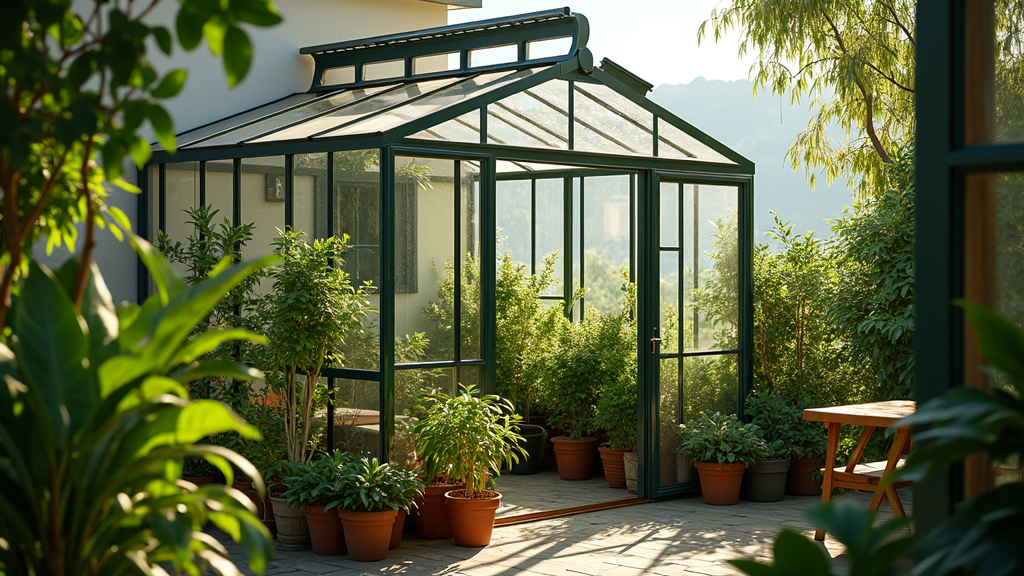Introduction To Small Space Greenhouses: What You Need To Know
If you’re short on yard space but still dream of growing fresh herbs, vegetables, or flowers year-round, a compact greenhouse might be your perfect solution. This introduction to small space greenhouses: what you need to know covers the key basics — like structure types, climate control, and layout strategies — so you can make informed choices before building or buying. Whether you’re outfitting a sunny balcony, a narrow side yard, or a corner of your deck, understanding the fundamentals will help you create a thriving mini-garden that makes the most of every square foot.

Taking on greenhouse gardening feels pretty exciting, especially if you love growing fresh herbs, veggies, or flowers but don’t have a big backyard. Small space greenhouses combine smart design with practicality, letting you nurture plants in even tiny apartments or modest outdoor spots. If you’re curious about how to start, what’s needed, and the basics of making it work, here’s my breakdown to help you get growing quickly.
What Are Small Space Greenhouses?
Small space greenhouses are compact structures made to fit tight spots, like balconies, patios, windowsills, or any nook that gets decent sunlight. They range from mini popup tents and shelving units wrapped in clear plastic, to small cold frames and prefabricated glass boxes. The main goal is to create a controlled environment that shields your plants from frosty weather, wind, and pests while also letting you start seeds earlier or grow crops for longer periods.
Beyond the convenience, these greenhouses offer budget friendly options and are less daunting than larger setups. For city dwellers or renters, they make gardening possible almost anywhere there’s enough light and a bit of unused space. You can move many models when seasons change, and some are designed to be packed away easily, making them extra practical for folks with changing needs over time.
What Do I Need to Know About Greenhouses?
A few important things to keep in mind before setting up a small greenhouse:
- Lighting: Sun is key. South-facing windows or patio spots typically get the most reliable light for healthy plant growth in the Northern Hemisphere.
- Ventilation: Even mini greenhouses can heat up fast. Opening zippers, lids, or windows keeps things from overheating and helps prevent disease.
- Material: Clear plastic covers are common and easy to move, but polycarbonate panels and glass box styles give better insulation. Some are more permanent, while others are meant for flexible or seasonal use.
- Water Access: Small greenhouses dry out surprisingly quickly. Watering within reach, without making a mess, helps regular upkeep. Consider keeping a small watering can handy.
- Protection from Pests: Greenhouses offer some help, but bugs can sneak in if left open for long stretches. Good airflow is important, so add mesh screens if you can.
- Scale and Limitations: Large vining crops like summer squash won’t work well in a tiny setup. Stick to compact or slow-growing plants: leafy greens, many herbs, strawberries, succulents, or microgreens are all comfortable in tight spaces.
Taking the time to plan out exactly where to put your greenhouse and what you want to grow will save time and cash later. Figure out what fits your lifestyle and available spots best.
** Here’s a little transparency: Our website contains affiliate links. This means if you click and make a purchase, we may receive a small commission. Don’t worry, there’s no extra cost to you. It’s a simple way you can support our mission to bring you quality content.**
As an Amazon Associate, I earn from qualifying purchases
How to Use a Mini Greenhouse for Beginners
Getting your mini greenhouse working is straightforward. Here’s a step-by-step guide to get started:
- Pick the Right Spot: Choose a space that gets at least 4 to 6 hours of sun daily. Patios, decks, bay windows, or south-facing spots work well.
- Set up the Structure: Assemble the greenhouse carefully and make sure it’s stable on a flat surface so it won’t tip over if winds blow hard. Use included tie-downs outdoors for extra security.
- Prepare Your Shelves or Surface: Arrange trays or shelves to allow airflow. Giving each plant some space keeps diseases at bay and lets everything grow evenly.
- Start Small: Herbs like basil and parsley are beginner friendly. Leafy greens are speedy growers too, and seed trays or small pots work great for them.
- Water Wisely: Heat builds up quickly, so soil dries fast. Water when the surface feels dry, but don’t let pots sit in soggy trays or waterlogged soil.
- Ventilate When Needed: On sunny days, open zippers or prop open vents to circulate air and keep the environment healthy.
- Watch for Pests: Check leaves every few days. Early action, like rinsing off aphids or snipping off affected leaves, makes a big difference.
- Harvest Regularly: Snip herbs and greens often. This keeps plants producing and prevents overcrowding in small quarters.
Mini greenhouses are portable and forgiving for beginners. Don’t hesitate to move them around if you notice better sun or easier access elsewhere. It’s all about learning what works.
Do I Need a Permit for a Small Greenhouse?
For most small or portable greenhouses, a permit isn’t usually needed. They rarely require a foundation and generally aren’t seen as permanent structures. Here’s what to keep in mind:
- Outdoor Small Greenhouses: If the structure is under about 100 square feet and not hooked into utilities, you’re likely in the clear. Always check with local zoning or your homeowners’ association to avoid surprises.
- Apartment Balconies or Decks: Talk to your landlord or property manager about specific guidelines. Some complexes have rules about weight limits, drainage, and how far anything can hang out over the edge.
- Permanent or Larger Greenhouses: Once you add a foundation, electricity, or plumbing, check with your building department before making big changes.
If you’re using a portable greenhouse, you’ll rarely face red tape. It’s always worth double-checking local rules so nothing trips you up down the line, especially if you’re a renter.
The Basics of a Greenhouse: How It Works
Greenhouses trap heat by catching sunlight inside a clear enclosure. When sun rays shine through, they warm up the air and soil; the heat stays put so your plants enjoy a milder, more predictable environment. Even small greenhouses use this same principle, helping you to:
- Start seeds before spring warms up
- Keep growing after summer cools off
- Shelter crops from nasty weather and wind
- Cultivate sensitive or tropical varieties that struggle outdoors
Inside, your plants are shielded from wild temperature swings. Stronger, more reliable warmth boosts germination and overall growth, even with minimal maintenance.
Tips for Success in Small Space Greenhouse Gardening
Making the most out of small spaces takes some creativity. Here’s a handful of helpful ideas:
- Use Vertical Space: Stackable planters or wall-mounted baskets help grow more in a little footprint. You could even hang small pots for extra crops.
- Pick Fast-Growing Crops: Quick salad greens, radishes, or dwarf herbs let you harvest more often and refresh with new plantings.
- Rotate and Refresh: Don’t stick with lagging plants; swap out old ones for new starts to keep everything lively and productive in a snug area.
- Keep an Eye on Temperature: A simple thermometer saves your plants from overheating. On bright days, open up a vent or a door slightly.
- Organize and Label: With less room, staying organized matters. Use tags or a notebook for planting dates and types, so you never lose track.
Fresh herbs, salads, and even the occasional flower are well within reach — even in the smallest setup — if you manage space and timing well.
Common Questions About Small Space Greenhouses
Here’s a few questions that come up a lot:
What do I need to know about greenhouses?
Greenhouses make use of sunlight to create a warm, shielded growing area for plants. Pay close attention to light, airflow, what kinds of plants fit your space, and make watering easy since small greenhouses need monitoring more frequently than big gardens do.
How to use a mini greenhouse for beginners?
Start with a spot that gets plenty of sun, add shelves or trays, and don’t bunch your plants too close. Water often, prop open the top or vents on hot days and begin with quick-growing greens or herbs to get the hang of it.
Do I need a permit for a small greenhouse?
Permit requirements are usually not an issue for tiny, portable greenhouses. Still, check with local authorities or your landlord to stay in the clear — especially in apartments or communities with set rules.
What are the basics of a greenhouse?
Sunlight, warmth, and shelter matter most. Greenhouses trap warmth so you can start growing early, extend harvests into cool weather, and protect delicate plants, even if you only have a small window or patio model.
Troubleshooting Small Space Greenhouse Problems
- Overheating: Small greenhouses can overheat quickly under direct sun. Open the top, unzip the cover, or leave a door cracked to keep temperatures safe.
- Mold and Mildew: Extra moisture and stagnant air cause mold. Cut back watering and let things air out regularly.
- Stretchy Seedlings: Weak, thin seedlings come from not enough sun. Move your greenhouse or add a simple grow light to help them thicken up.
- Pests: Regularly tidy up and look for bugs. Wash away aphids or use gentle organic sprays as soon as you see problems.
Best Plant Choices for Small Greenhouses
These plants thrive in compact climates:
- Herbs: basil, parsley, cilantro, chives, mint
- Leafy greens: lettuce, spinach, arugula, kale
- Strawberries (choose container or hanging types)
- Cherry tomatoes (try dwarf or patio varieties)
- Succulents and microgreens
Search seed companies for “bush,” “patio,” or “mini” varieties. Smaller and container-adapted plants need less root space and work perfectly in your tiny spot.
✅ ** Conclusion:
Small space greenhouses give a boost to city gardeners and folks with limited outdoor room. Flexible, affordable, and fun, these setups let you nurture plants with minimal fuss or investment. All it takes is a little knowhow: select a sun-drenched spot, pay attention to airflow and water, and stick to compact or quick-turn crops. Before long, you’ll be snipping fresh greens or herbs right from your apartment garden—no big backyard necessary!
Getting started with a small space greenhouse doesn’t have to be overwhelming—it just takes the right information and a little planning. From selecting the right greenhouse size to choosing mini greenhouses for patios and balconies, you have plenty of options tailored to your space and lifestyle.
Equipping yourself with essential greenhouse gardening tools and learning about ventilation in compact greenhouses will give your plants the best shot at thriving.
Don’t forget to stay ahead of the curve by avoiding common beginner mistakes and following simple maintenance practices to keep your greenhouse flourishing year-round.
Whether you’re growing herbs, veggies, or just a few flowers, a small greenhouse can turn even the tiniest space into a vibrant, productive garden. Ready to get started? Explore our full collection of tips and ideas here on SmallGardenBox.com and start building the greenhouse that fits your life.

Leahrae
This is a great introduction to small space greenhouses—very clear and practical! I love how you cover everything from lighting and ventilation to material choices and plant selection, which really helps set realistic expectations for anyone new to greenhouse gardening.
Out of curiosity, what’s been your favorite compact greenhouse setup or plant combination that thrives in a really tight space?